M7.4 earthquake strikes the Kamchatka Peninsula
Questions about megaquake advisories, revived?
Чтобы прочитать эту публикацию на русском языке (автоматический перевод Google), нажмите здесь.
Earthquake Insights is an ad-free newsletter written by two independent earthquake scientists. Our posts are written for a general audience, with some advanced science thrown in! To get these posts delivered by email, become a free subscriber. If you would like to support our work here, please also consider a paid subscription. If you use our Substack as part of a group, or for teaching, consider a teaching or institutional subscription. Every paid subscription makes a difference!
If you have recently lost your job or are a student or researcher without ability to pay, let us know and we will upgrade your subscription to “paid” at no cost.
At 18:49 local time (06:49 UTC) on July 20, 2025, a M7.4 earthquake struck off the eastern coast of Russia’s Kamchatka Peninsula. The USGS estimates that about a quarter of a million people living on the peninsula felt at least moderate shaking (intensity V); damage is expected to be limited. This relatively modest shaking can be credited to the distance of the earthquake from nearby population centers (~130+ kilometers).
The earthquake was preceded by a series of foreshocks. Interestingly, there were two steps up in the foreshock sequence. The first foreshock was a M5.0 at 06:02 UTC. That event triggered a M6.7 earthquake twenty-six minutes later. The M6.7 was followed by a handful of M4-5 aftershocks; then, twenty-one minutes later, the mainshock (M7.4) occurred. It is important to note that the seismic characteristics of foreshocks, mainshocks, and aftershocks are not fundamentally different. We give these names to earthquakes after we observe the sequence. If a larger earthquake were triggered in the next days or weeks, we could rename the M7.4 a foreshock, and that new earthquake would become the mainshock.
IRIS provides rapid access to seismic traces from global seismographs contributed by a range of institutions, which can be a fun way of exploring recent earthquakes. Below, we have annotated a recording from a single seismometer that saw the foreshocks, mainshock, and some of the early aftershocks:
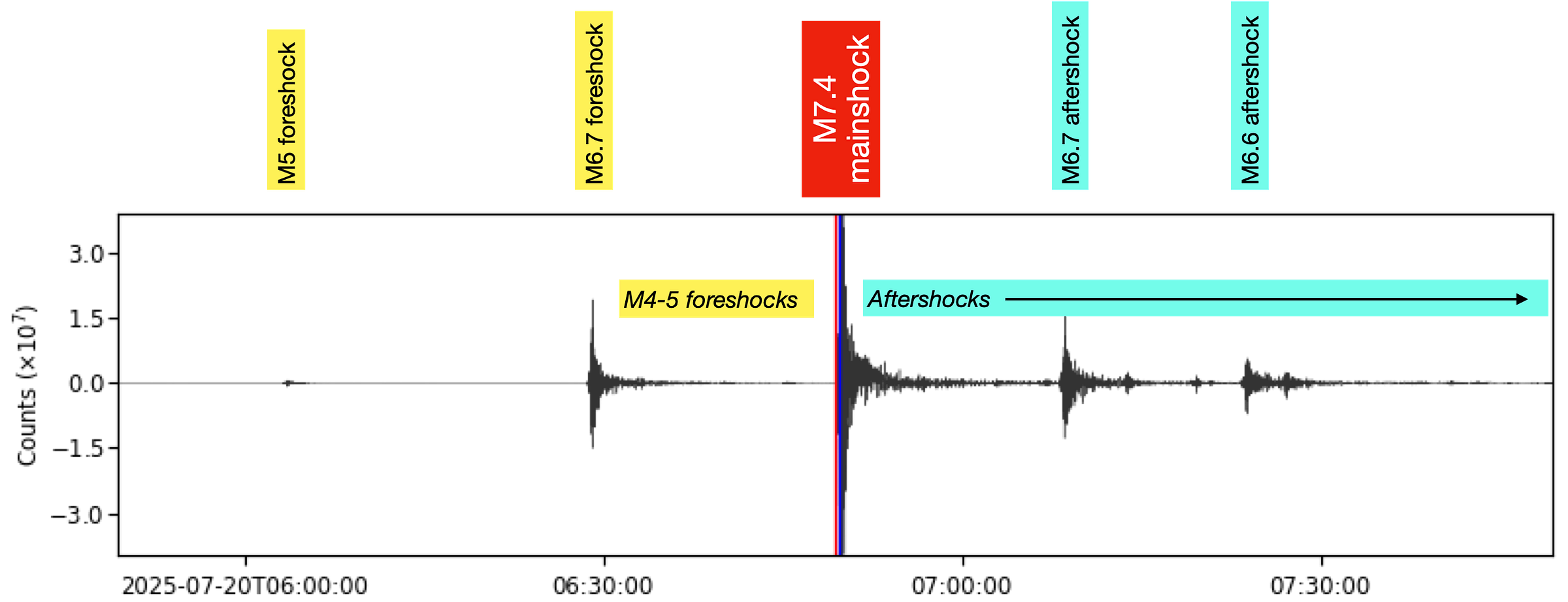
The M6.7 foreshock was large enough to be felt, but the shaking was not very strong. Testimonies to the EMSC describing the experience include:
“Хорошо качало” (“It was a good pump”)
“Офигенно было “ (“It was awesome”)
”Хорошо покачало 👍🏼” (“It was a nice rock 👍🏼”)
The M7.4 was less well received.
“Сильно трясло.” (“It was shaking violently”)
”Вот это была жопа” (“That was a disaster”)
”Хорошо потрясло, Люди выбежали” (“It shook well, people ran out”)
Tsunami warning, now passed
Like we saw after the M7.1 earthquake offshore Alaska four days ago, a tsunami warning was issued by the Pacific Tsunami Warning Center (PTWC). The tsunami threat has now passed. You can find all of the most recent PTWC messages here.
The PTWC website can be a little confusing, because new messages are posted as more information is received (either about the source, or about any waves generated by the source), and tsunami threats are location dependent, so one earthquake may produce many messages. For instance, in the case of the recent M7.4 earthquake, there are eight alert messages. To find the latest information, look for the highest message number for a given area: for instance, “Non-US/Canada Pacific Threat #3,” skipping over #1 and #2.
With earthquakes, early warning systems have to operate extremely fast, because ruptures and seismic waves travel at several kilometers per second — the whole system has to be highly automated. Tsunamis are much slower (although in the deep ocean they travel faster than most jet planes), so there is more time for a tsunami warning system to operate, and for people to look at the data. This may not work for those living along coasts very near the earthquake, although they usually get a natural warning: the shaking itself. However, for people further away, hours may pass between the earthquake and the arrival of tsunami waves. You can explore this website by NOAA, which has maps of approximate travel times in hours for a variety of earthquake source locations. For the recent earthquake, if a hazardous wave had been generated, there would have been a delay of ~6-7 hours before that wave arrived at Hawaii.
This is very relevant information because tsunamis raised along the Japan-Kamchatka-Aluetian plate boundary have certainly produced huge transoceanic tsunamis many times in the past.
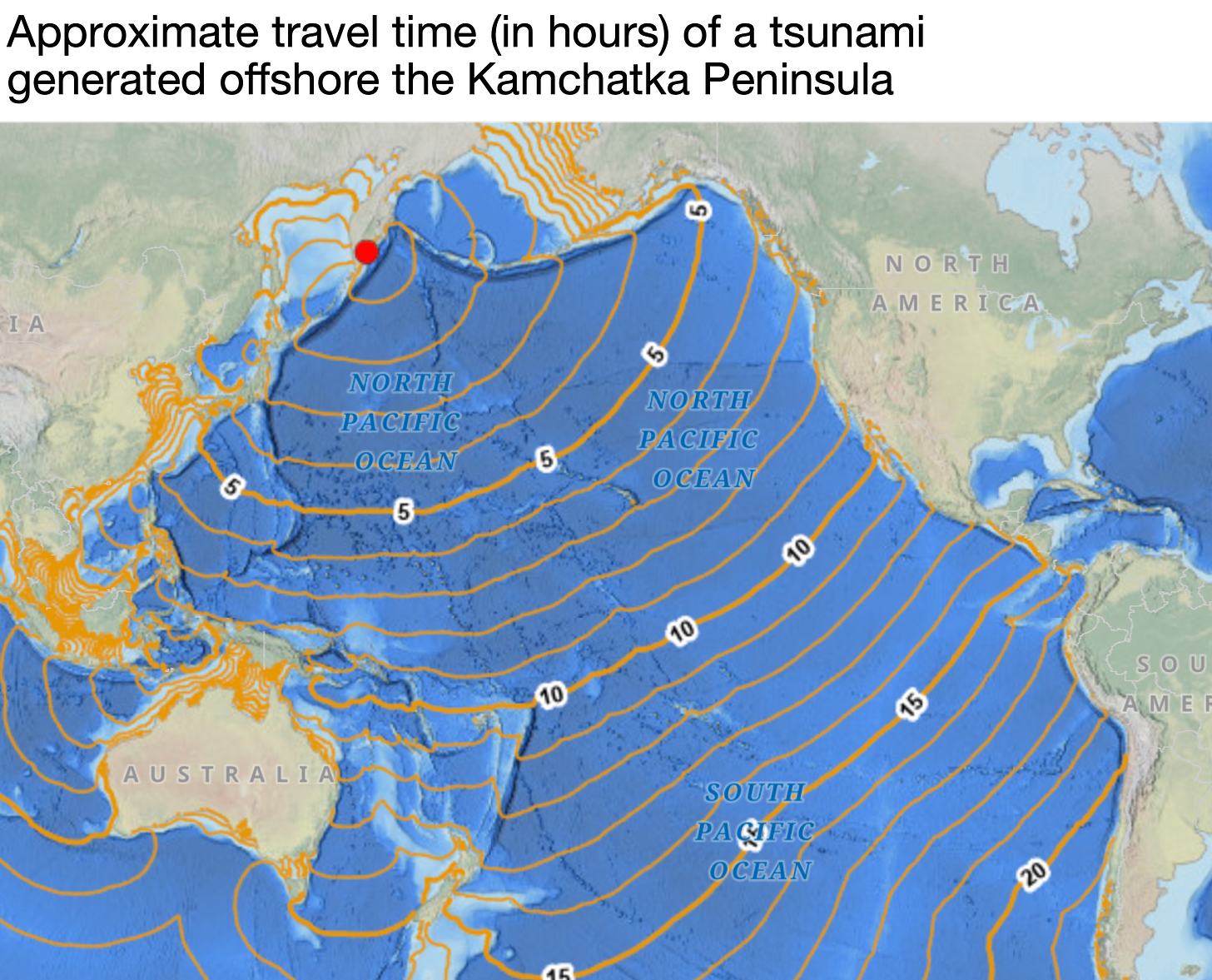
Tectonic setting
The earthquake occurred along the subduction zone that borders the southeastern side of the Kamchatka Peninsula. Here, the Pacific Plate collides with the Okhotsk Plate at about 8 centimeters per year. The old, cold oceanic lithosphere of the Pacific Plate is the more dense of the two, and it sinks down into the mantle. Subduction zones produce a wide variety of earthquakes, associated variously with slip on the interface between the two plates (the “megathrust”), with deformation of the sinking slab as it bends and breaks, with deformation of the overriding plate as it is squeezed or stretched, and with the volcanoes that form above the slab as fluids are released and cause melting.
The recent M7.4 earthquake fits neatly into that first category: its location and depth place it close to the megathrust, and the focal mechanism is consistent with slip on that low-angle thrust fault. The aftershocks mostly plot above the megathrust; at this point, these appear to largely have been assigned default depths. We will likely see revision of these data over time, as solutions improve.
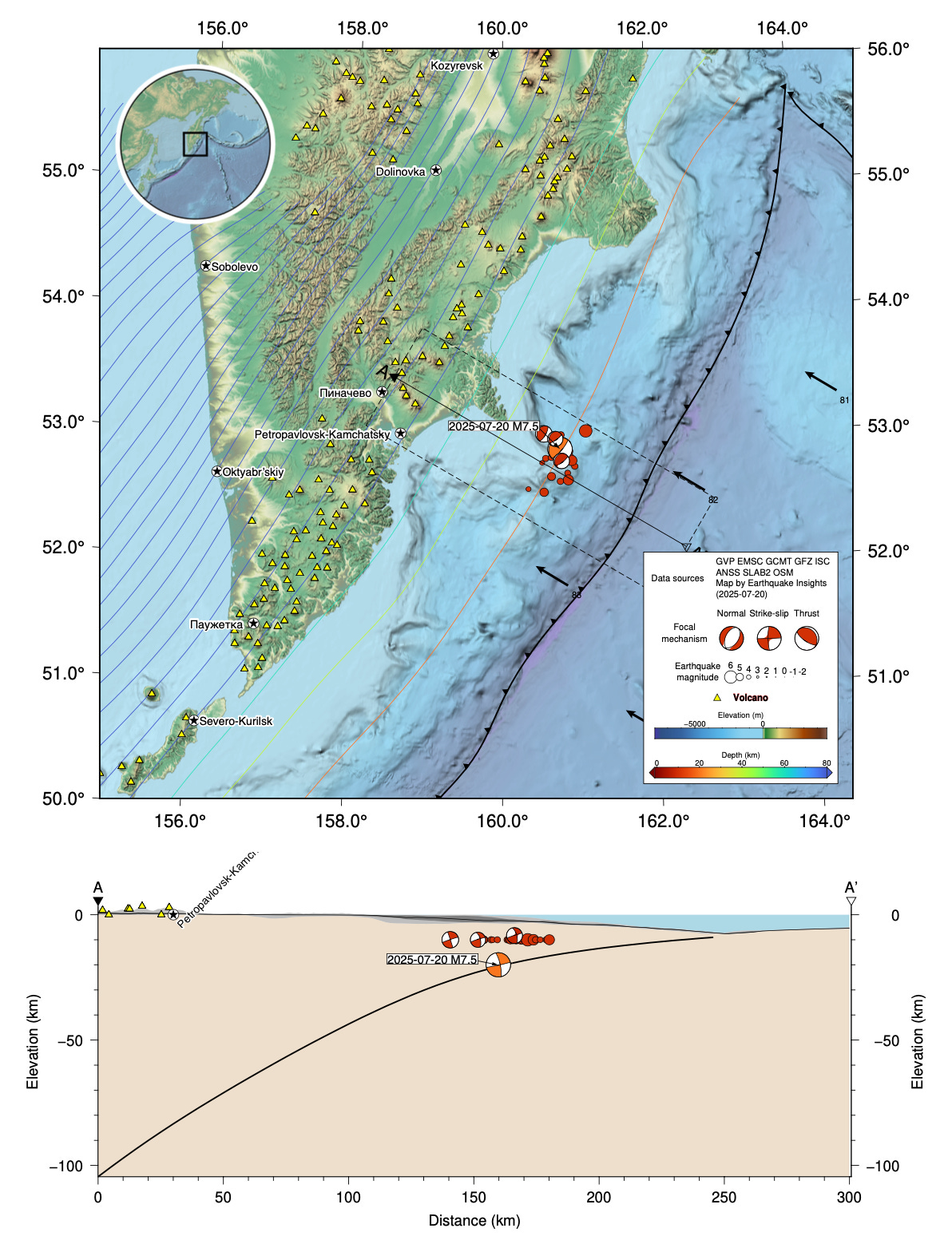
Also: wow, that’s a lot of volcanoes! One popular question in earthquake science is whether earthquakes can trigger volcanic eruptions, or vice-versa. The short answer is that in some cases, it is technically plausible that stresses from one might be capable of impacting the other, but the evidence that this actually occurs is extremely slim at best — in large part, because of the distance between great subduction earthquakes and volcanic arcs.
Earthquakes off the Kamchatka Peninsula
We last wrote about earthquakes in this area in August 2024, after a M7.1 earthquake struck very close by. In fact, the rate of seismicity in the neighborhood of that event is still elevated, almost one year later — this is the long tail of aftershocks that we often see following large earthquakes.
This raises some curious questions about earthquake semantics. If the M5.0 foreshock had occurred on its own, we would call it an aftershock of the earlier M7.1, because the seismicity rate is still elevated. Does that mean that anything triggered by the M5.0 is also an aftershock of the M7.1? Since the M7.4 is the largest event in the sequence, that would make the M7.1 a foreshock. However, the M5.0 could also have occurred on its own: in addition to the aftershocks, the area has a natural background rate of seismicity that is fairly high. Because of the time gap between the M7.1 and M7.4, describing the first event as a foreshock is a bit uncomfortable, although it is a very plausible relationship.
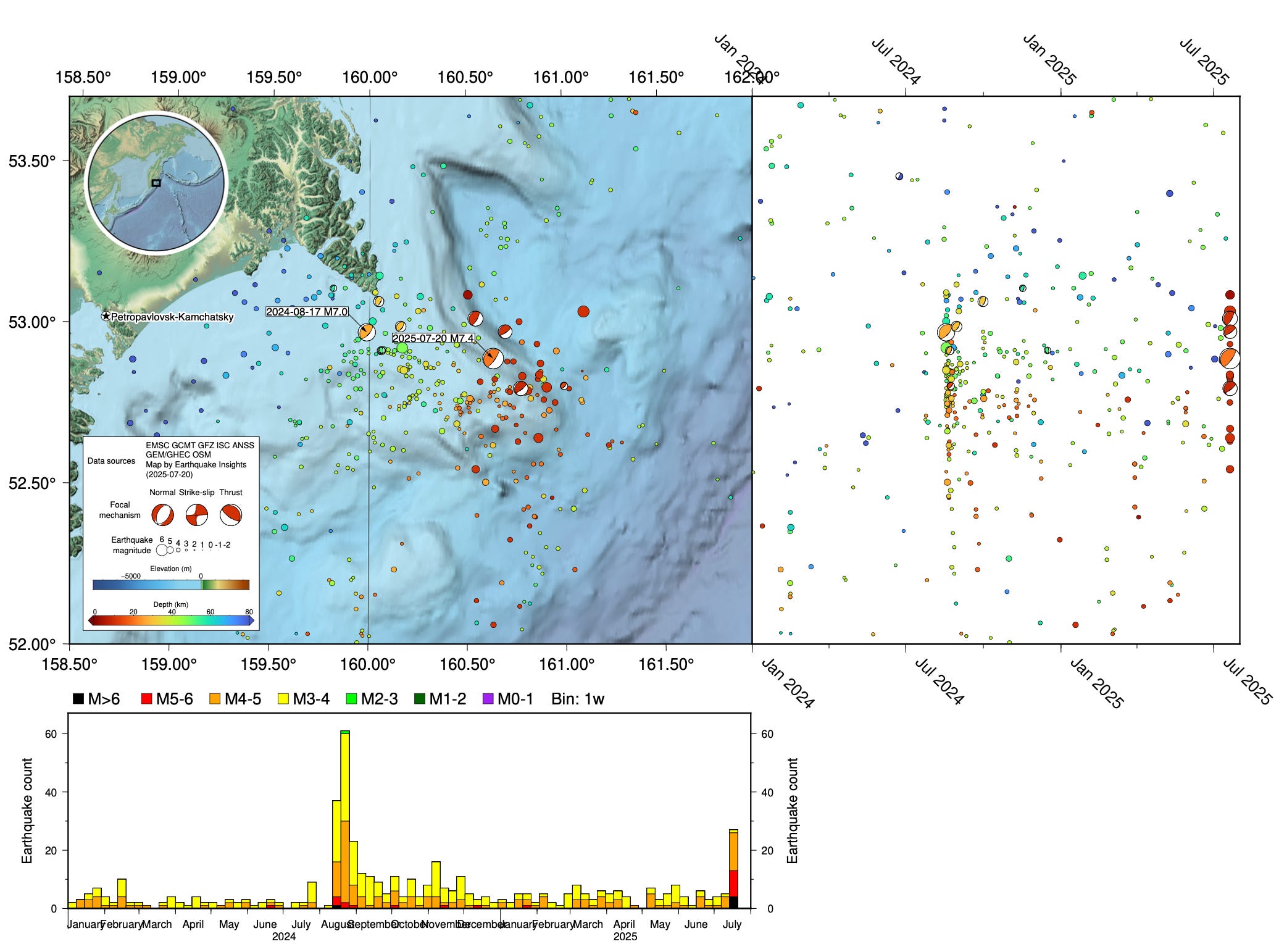
This whole question all becomes a little more intriguing in light of our previous post about the M7.1 earthquake.
That earthquake occurred soon after a similar-magnitude earthquake in southern Japan, which was used at the basis for a “megaquake warning” for the Nankai subduction zone: an alert that the risk of a great earthquake along the subduction zone was elevated. At Nankai, history tells us that great (~M9) subduction earthquakes occur periodically; at Kamchatka, history tells us the same thing. In fact, the fifth largest earthquake ever recorded occurred here in 1952 (M9.0), initiating near the location of both last year’s M7.1 and the more recent M7.4. We wrote about the 1952 earthquake in our previous post, even showing a purported video the tsunami wave arriving at the coastline. That earthquake and its tsunami combined killed 10,000-15,000 people: one of the great earthquake disasters.
The question we asked then was: if a M7+ earthquake in Nankai should be used as the basis of a megaquake warning, because of the elevated risk of a triggered great earthquake, should a M7+ earthquake in Kamchatka be treated the same way? At the time, we wrote:
We believe that the justification for such a system at Kamchatka is as good as for a system at Nankai. If such a system were in place at Kamchatka, an alert would have been triggered by the recent M7.0. Indeed, the justification is probably stronger for this latest earthquake than for the advisory at Nankai, since the M7 in Kamchatka occurred close to the nucleation zone in 1952, while the M7.1 offshore Nankai occurred to the south of the expected rupture zone.
It is undoubtedly true that if such megaquake alert systems were applied to all subduction zones around the world, some fraction of great earthquakes would occur during alert periods. Of course, a much larger fraction would not, simply because most great earthquakes are not preceded by foreshocks. And of course, alert systems would be triggered many times, and then expire without great earthquakes.
Fortunately, and unsurprisingly, the Nankai megaquake alert passed with no great earthquake. If a similar alert had been raised following the M7.1 in Kamchatka, it, too, would have been a false alarm. And yet, that M7.1 earthquake could plausibly be described as a foreshock of the larger M7.4 that just occurred. The time gap here illustrates the problem: while the greatest risk of triggering is in the hours and days immediately following an event, the long tail of aftershocks means that triggered events can still occur weeks, months, or in this case almost a year later.
The second problem is this: when an earthquake triggers another earthquake larger than itself, “larger” can mean a lot of things. A M7.4 is undoubtedly larger than a M7.1: it releases about three times as much energy. But the great earthquakes that we are more worried about are much, much larger than that — a M9 is about 700 times more powerful than a M7.1. It is for that reason that great earthquakes are so damaging, and able to raise huge tsunamis, while a M7.1 in the same location can be described as “a nice rock 👍🏼”.
For this reason, a megaquake advisory in Kamchatka following the M7.1 would not only have missed the triggered earthquake, but also would have been unnecessary, since the M7.4 was not particularly damaging.
So, are megaquake advisories worth it? In our opinion, the jury is still out on this one.
As we wrote in 2024:
Would the benefit outweigh the cost? That depends entirely on the actions taken by people and agencies on the ground in response to an alert. At Nankai, the advisory for most people was just a reminder to review their earthquake preparedness: secure their homes and workplaces; make sure their emergency supplies were in order; and review their tsunami evacuation routes — not so heavy a burden. Being prepared for an earthquake is never bad.
And now, a bonus section!
Two M7+ earthquakes within four days — unusual, or not?
We find ourselves writing about a second large earthquake within only four days, following a long period when we were less active because few big earthquakes were happening.
Is it particularly unusual for two M7+ earthquakes to strike different areas of Earth, within only days of each other, as has just happened? Let’s look at the data.
As far as we can tell, earthquakes happen (mostly) randomly in time (aftershocks, swarms, triggered, and anthropogenic earthquakes excepted), but at a rate that is predictable over the long term, and is presumably determined by tectonic motions. This is similar to radioactive decay: the long-term rate of decays is described by a decay constant that arises from some deep atomic physics, but the decay event times are themselves random. The probability distribution that results is called a Poisson distribution.
Starting with the USGS catalog, we generated the set of M7+ earthquakes that did not occur within 1000 kilometers of the preceding M7+ earthquake, since 1976. By excluding the events following a nearby large earthquake (89 out of 687 events), we can pretty confidently remove most aftershocks, swarms, triggered events, and anthropogenic earthquakes.
Does the Poisson distribution actually describe our particular dataset? We performed a quick fit to the data:
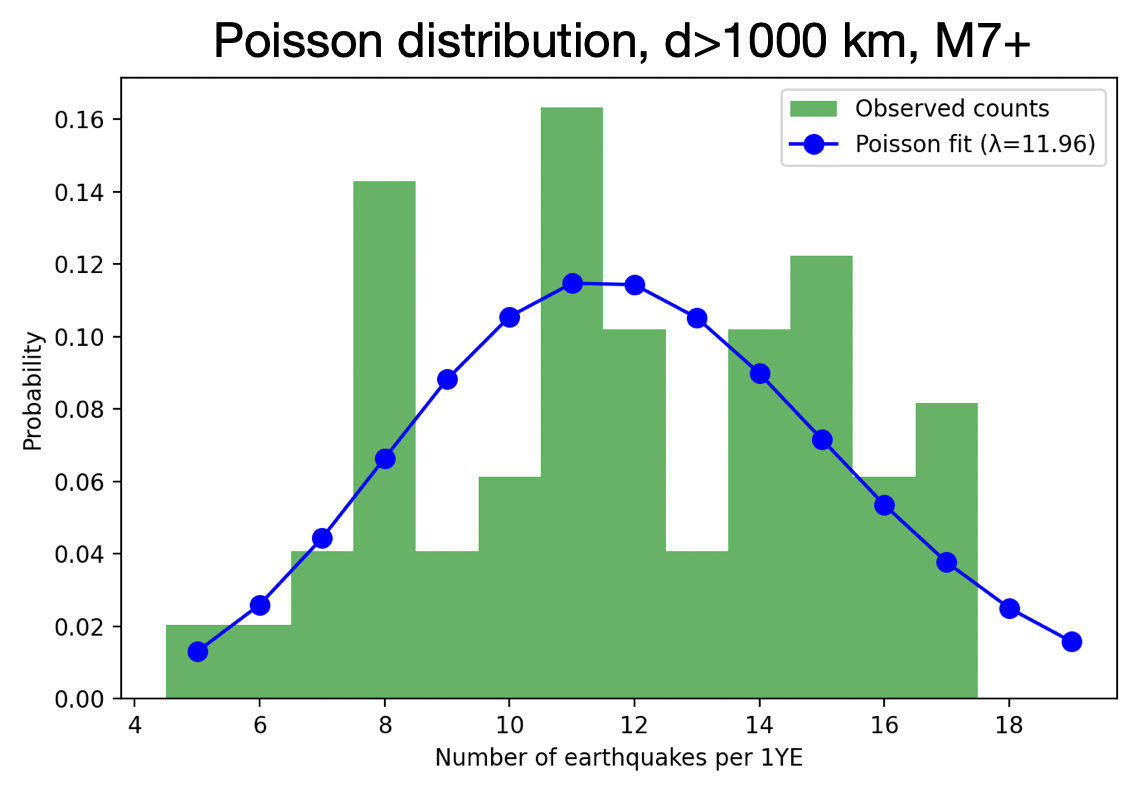
Squint hard enough and you might say “yes.” Maybe with a few thousand more years of data, the curve will fill out better. The model fit says that there are about twelve such earthquakes per year on average, but some years have as few as five, and some as many as seventeen.
For this discussion, we mostly care about how often we expect to see independent earthquakes that are close together in time — that is the background rate against which we will consider the pair of earthquakes that happened this week. If the earthquake occurrence rates are Poissonian (described by a Poisson distribution), then the time intervals between earthquakes will be described by an exponential distribution. This means that small intervals between events (interarrival times) will naturally be much more common than interarrival times.
And, in fact, the data do seem to have this property. The mean inter-arrival time is 28.3 days, and the expected rate of occurrence is 0.0353 events per day.
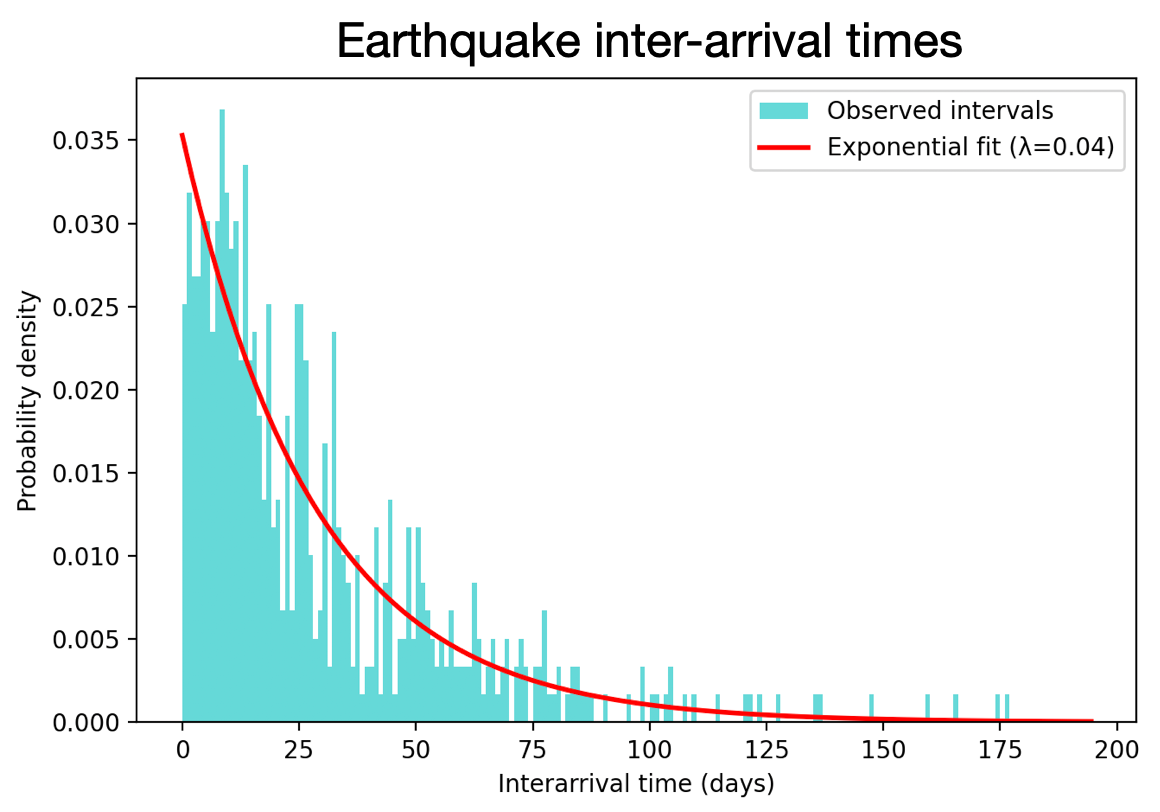
So, it is completely unsurprising that we sometimes witness M7+ events happening close together in time but far apart in space — and there is no reason to ascribe that to anything but coincidence. The interesting part is that shorter time intervals are always more expected! We’re not sure if this is intuitive or not, but we have noticed that many people become particularly curious when large earthquakes happen close together in time. It probably has to do with the difficulty of mentally binning data with equal-width bins…
From the fit to the data (the red curve), we can directly calculate the probability that a remote M7+ earthquake will have an interarrival time less than or equal to the 3.42 days between the recent Aleutian and Kamchatka earthquakes: using actual math, we estimate an about 11.4% chance. If we just sort our event pairs by inter-event time, we also see that our current pair is number 60 out of 598; about 10%.
So, it’s not really that uncommon!
OK, we will admit that we also care about statistical extremes, although exactly why is unclear.
What is the shortest inter-arrival time for sequential M7+ earthquakes located more than 1000 km away from each other?
The current record for shortest inter-arrival time is held by two M7.1 earthquakes that occurred on May 24, 1990. The first event was a shallow earthquake in South Sudan, which itself was a large aftershock of a M7.2 earthquake that occurred just 4.7 days earlier. This was followed only 555 seconds (9.25 minutes) later by a very deep intraslab earthquake beneath the Flores Sea of Indonesia, at 586 kilometers depth. Measured across Earth’s surface, these events were 9,921 kilometers apart.
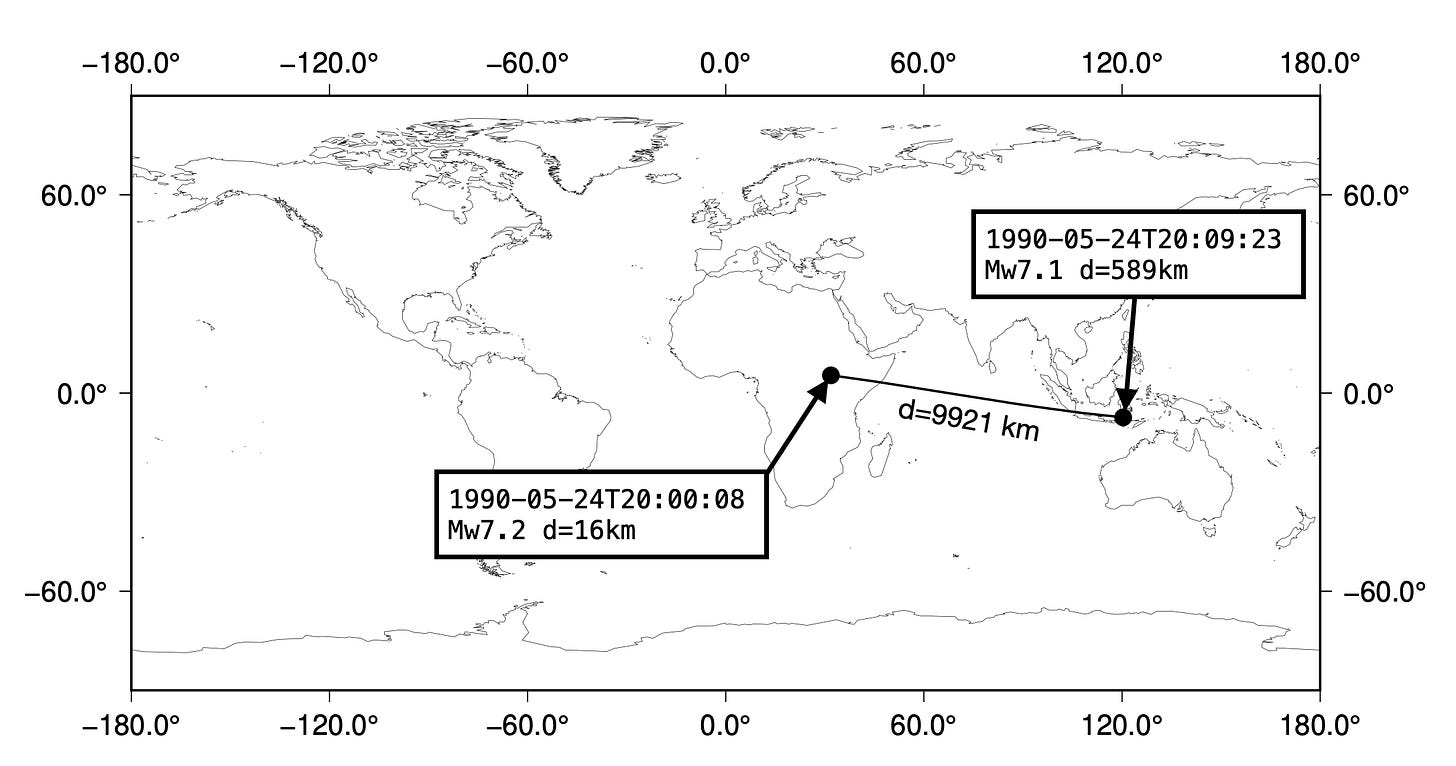
Sometimes, a remote earthquake can be triggered by the passing seismic waves from another earthquake. This is called dynamic triggering. Could this process explain our record-winning earthquake pair? Let’s check.
Using ObsPy and the IASP91 global seismic wave velocity model, we calculated how long it would take the first seismic waves from the South Sudan earthquake to reach the hypocenter beneath the Flores Sea; we estimate about 707 seconds after the origin time. (We actually did the calculation backwards, from the second to the first earthquake!)
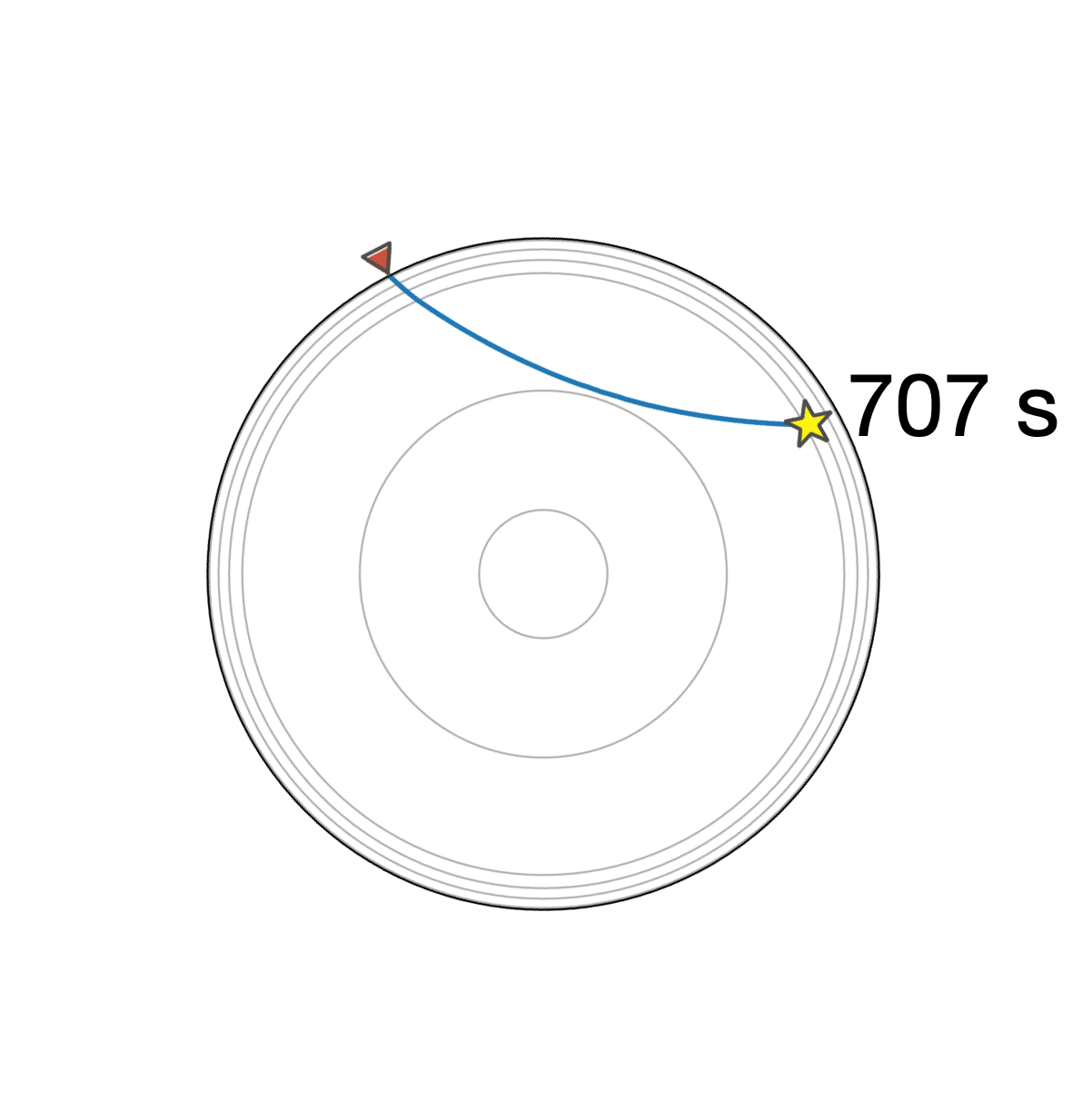
The South Sudan earthquake could not have dynamically triggered the Flores Sea earthquake only 555 seconds later. In fact, the second earthquake happened while the first waves were still making their way through Earth’s interior! It is interesting to think that the wave fields from these two earthquakes actually met up inside Earth, like some sort of seismological Avada Kedavra vs. Expelliarmus. Hmm.
Unlike magical spells, the waves did not collide in a writhing mass of good versus evil, but rather passed through each other, creating an interference pattern that must have been a little confusing to the seismologists in charge of analyzing and interpreting seismic waves.
The record-winning 9.25 minute interval is quite short. The runners-up in the contest are a pair of earthquakes on March 24, 1978, which occurred 5,480 kilometers apart, separated by a much longer 1 hour and 18 minutes!
What about the longest interval between two remote M7+ earthquakes? The current record is 176.8 days; the unusually long quiet period was finally broken by the 2017 Komandorski Islands earthquake, along the westernmost Aleutian Island chain.
What is the probability that the inter-arrival time would be longer than one year? Again using our red curve above, we calculate the probability is about 0.00025%. We think that means it will usually take about 31,000 years to see that occurrence… that's called job security for people like us!
References:
Bradley, K., Hubbard, J., 2024. M7.1 strikes offshore Kamchatka - in an area that nucleated a M9 in 1952. Earthquake Insights, https://doi.org/10.62481/33403660







Another of your insightful, articulate, comprehensive and seismically concise discussions of a notable tectonic event. Not only does it serve as dissection of the activity, but it’s also a 200 level college geology course in the nature of foreshocks, main shocks and aftershocks. A few more of these and I’ll have enough credits for a degree in seismology. 😏
Informative and again, extremely well written. Thank you thank you!